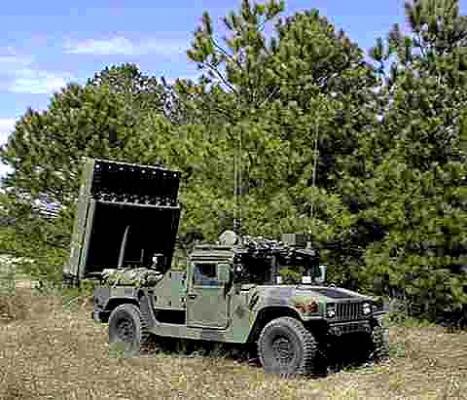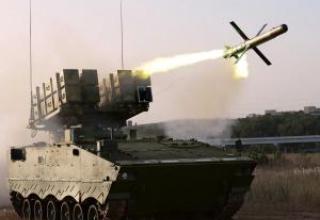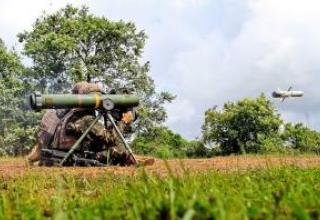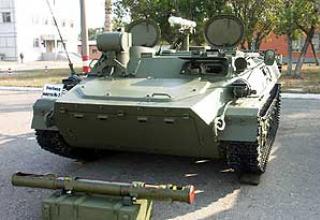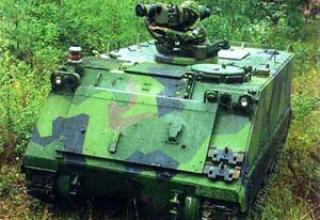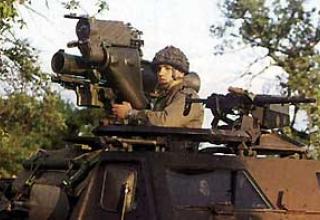The EFOGM (Enhanced Fiber Optic Guided Missile) missile system is primarily designed to fight tanks, as well as to defeat air targets (helicopters) flying at extremely low and low altitudes using masking terrain properties and other terrain features. The maximum range of fire on air and ground targets, according to tactical and technical requirements, shall be at least 10 kilometres.
According to reports in the foreign press, two variants of structural execution of a complex are provided: on the basis of multipurpose vehicle of high cross-country ability M988 "Hammer" for light divisions (8 missiles on PU) and on the basis of the tracked self-propelled chassis of multiple launch rocket system MLRS (24 missiles on PU) for "heavy" divisions. The U.S. Army plans to supply 118 and 285 systems in the first and second variants respectively, as well as 16550 missiles. Their cost will be 2.9 billion dollars.
After competitive evaluation of the proposed projects, the developers of the complex were selected by Boeing (the complex as a whole and the guidance station) and Rytheon (the missile).
Composition:
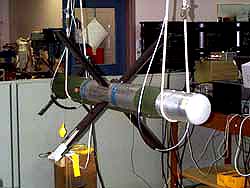
The FOGM consists of a rocket, a packet-type launcher and guidance equipment with an operator's console. According to foreign military experts, the key element of the FOGM complex that determines its ability to hit targets outside the line of sight is the MGM-157(YMGM-157B) missile for guidance which uses fiber optic cable. The missile is equipped with launch and march solid propellant rocket engines, which are placed tandem in the middle part of the hull and have common nozzles installed at an angle to its longitudinal axis. The fuel used is a special low smoky, slow burning compound developed by ARC (Atlantic Research Corporation). Ahead of the engines there is a combat unit, and behind them there is a power supply source, a unit of onboard flight control equipment, a coil with a fiber-optic cable (diameter 240 microns), aerodynamic controlled surfaces and their drives. Control surfaces and four intermediate wings, installed near the center of the rocket mass, are made folding.
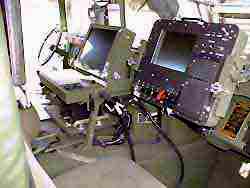
In the nose section there is a television camera, which transmits the image of the terrain in front of the flying rocket via fiber optic cable to a self-propelled launcher, where it is played on the screen of the operator's control panel. The latter searches for an air or ground target and then automatically or manually points the missile at it. Control commands transmitted via fiber optic cable on board the missile are generated by a digital device. The missile is launched vertically and then flies horizontally along a pre-determined non-ballistic trajectory, controlled by an inertial system (although even in this section, operator intervention is not excluded) to the target area.
Due to the specifics of the trajectory, the tanks are hit from above in the least protected areas.
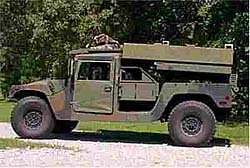
In addition to the TV camera described above, an advanced combination head with TV and thermal imaging channels has been developed. In the focal plane of the optical system of this head there is a receiver of infrared radiation of matrix type. The matrix of detectors (640 X 480) is made on a hybrid crystal of platinum silicide. The receiver is cooled with liquid nitrogen.
Foreign experts believe that the YMGM-157B missile, equipped with an advanced head, will have a higher flight speed, and the maximum range of the EFOGM complex will exceed 15 km.

The launcher of the complex is equipped with radio communication, NAVSTAR satellite navigation system, operator's console and computing device. It is provided with guidance of two missiles simultaneously. To synchronize and coordinate actions on the battlefield, the PU is combined with the battle control systems of AFATDS (Advanced Field Artillery Tactical Data System) and FAAD 2CI (Forward Area Air Defence, Command, Control and Intelligence) of the brigade. Targeting can go through all channels, including from a reconnaissance aircraft.
The PU crew is 2 persons. The launcher can be airlifted by C-130 aircraft and Chinook helicopters with external sling.
Characteristics:
| Defeat zone, km | 10-15 |
| Rocket diameter, m | 0,15 |
| The length of the rocket, m | 1,5 |
| Motor type | solid fuel 2x mode |
| Management | over fiber optic cable. |
| Flight controls | rotary aerodynamic surfaces. |
| Number of warheads | 1 |
| Start weight,kg | 45 |
Testing:
Experimental and design work on the creation of the "Dam" complex was carried out on the basis of the USSR Council of Ministers Decree of December 31, 1969 № 999-362 (Order of the Minister of Mechanical Engineering of January 22, 1970 № 23 on the tactical and technical task of 62758 with the deadline for submission for state testing in the second quarter of 1972.
At the testing stage, as a combat vehicle of the self-propelled shore-based jet bomb of the "Dam" complex was used a regular combat vehicle BM-21 system "Grad", modified to reduce the force of locking force, as well as its re-equipment converter to provide power supply to electrical equipment (guidance of the launcher) from the industrial power grid.
Experience of development of "Dam" complex has shown impossibility in short term (according to the plan the term of 3 months was established) to perform works on updating and reissue of the documentation by results of factory tests and to make on it the state party. Usually it required at least 9-12 months.
By results of performance of works by the sketch design (June, 1971) the complex has been recommended on factory testing (the conclusion in part 62758, out. № 715/003803 from 09.09.1971).
The factory development should have been confirmed by the results of the following tests:
- 15 poster bombings of combat units;
- 99 rocket engine bench tests;
- 500 launches of projectiles from a combat vehicle, of which 400 launches at the Institute "Geodesy" and 100 launches in 78384.
As part of the factory development work, various types of them were entrusted:
- Chapaevsky Chemical Plant - filling combat units with explosives.
- Institute "Geodesy" - carrying out flight tests.
- Perm Machine-Building Plant named after V.I. Lenin - delivery of two combat vehicles BM-21PD: one to the Institute "Geodesy" and the second in 78384.
- Research Institute "Search" - detonators 95VZ.
- Leningrad Research Institute of Chemical Instrument Engineering - protected pyropatroons PP-9RS-3N.
As of March 15, 1972, the factory development could be completed by June 15, 1972.
In 1984, Vanin Evgeny Sergeevich for his work on the topic: "Ammunition to the self-propelled shore-based jet complex "Dam" (work presented by NPO SPLAV was awarded the prize named after S.I. Mosin. He was directly involved in the development of the "Dyamba" complex and the ammunition for its ORS-60.
